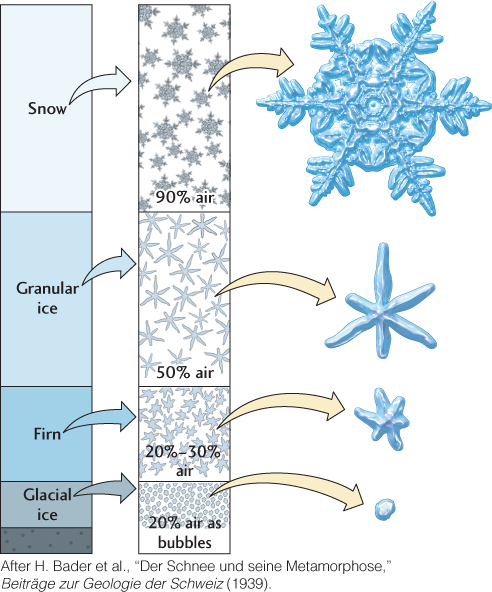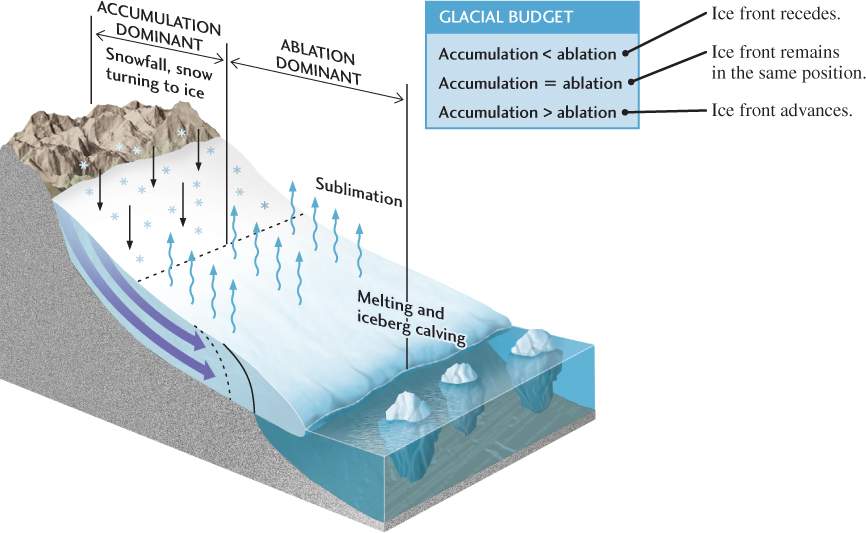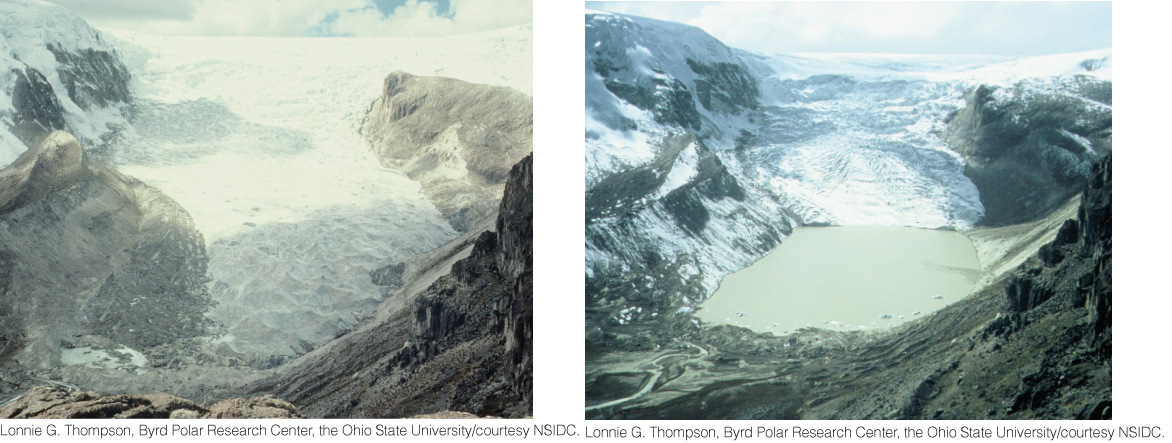How Glaciers Form
A glacier starts with abundant winter snowfall that does not melt away in the summer. The snow is slowly converted into ice, and when the ice is thick enough, it begins to flow.
Basic Ingredients: Freezing Cold and Lots of Snow
For a glacier to form, temperatures must be low enough to keep snow on the ground year-round. These conditions occur at high latitudes, because the Sun’s rays strike Earth at low angles there (see Figure 19.1), and at high elevations, because the atmosphere becomes steadily cooler up to altitudes of about 10 km (see Figure 15.2). Therefore, the height of the snow line—the elevation above which snow does not completely melt in summer—generally decreases toward the poles, where snow and ice cover the ground year-round even at sea level. Near the equator, glaciers form only on mountains that are higher than about 5000 m.
The precipitation of snow and the formation of glaciers require moisture as well as cold. Moisture-laden winds tend to drop most of their snow on the windward side of a high mountain range, so the leeward side is likely to be dry and unglaciated. Parts of the high Andes of South America, for instance, lie in a belt of prevailing easterly winds. Glaciers form on the moist eastern slopes, but the dry western side has little snow and ice.
The coldest climates are not necessarily the snowiest. Nome, Alaska, has a polar climate with an average annual maximum temperature of 9°C, but it gets only about 4.4 cm of precipitation a year, virtually all of it as snow. In comparison, Caribou, Maine, has a cool temperate climate with an average annual maximum temperature of 25°C, and its average annual snowfall is a whopping 310 cm. Nevertheless, the conditions around Nome, where little of the snow melts, are better for the formation of glaciers than those in Caribou, where all the snow melts in summer. In arid climates, glaciers are unlikely to form unless the temperature is so frigid throughout the year that very little snow melts, as in Antarctica.
592
Glacial Growth: Accumulation
A fresh snowfall is a fluffy mass of loosely packed snowflakes. As these small, delicate ice crystals age on the ground, they shrink and become grains, and the mass of snowflakes compacts to form a dense, granular snow (Figure 21.7). As new snow falls and buries the older snow, that older, granular snow compacts further into an even denser form, called firn. Further burial and aging eventually produce solid glacial ice as the grains recrystallize and are cemented together. The whole process may take only a few years, although 10 to 20 years is more likely. When ice accumulates to a mass sufficient for gravity to act on it, a glacier is born. A typical glacier adds a layer of ice each winter as snow falls on its surface. The amount of ice added to the glacier annually is its accumulation.

As glacial snow and ice accumulate, they entrap and preserve valuable relics of Earth’s past. In 1991, mountaineers discovered the body of a prehistoric human preserved for more than 5000 years in Alpine ice on the border between Austria and Italy. In northern Siberia, extinct animals such as the woolly mammoth, a great elephant-like creature that once roamed icy terrains, have been found frozen and preserved in ancient ice. Ancient dust particles and bubbles of atmospheric gases are also preserved in glacial ice (see Figure 21.1). Chemical analyses of air bubbles found in very old, deeply buried Antarctic and Greenland ice have shown us that atmospheric carbon dioxide concentrations were lower during the most recent (Wisconsin) glaciation than they have been since the glaciers retreated (see Figure 15.11).
Glacial Shrinkage: Ablation
As a glacier flows downhill under the pull of gravity, it flows to lower altitudes where temperatures are warmer, and it loses ice. The total amount of ice that a glacier loses annually is called ablation. Four mechanisms are responsible for ablation:
- 1. Melting. As the ice melts, the glacier loses material.
- 2. Iceberg calving. Pieces of ice break off and form icebergs when a glacier reaches a shoreline (see Figure 21.3).
- 3. Sublimation. In cold climates, water can be transformed directly from its solid state (ice) into its gaseous state (water vapor).
- 4. Wind erosion. Strong winds can erode glacial ice, primarily by melting and sublimation.
Most ablation takes place at the glacier’s leading edge. Therefore, even when a glacier is advancing downward or outward from its center, its leading edge—the ice front—may be retreating. The two mechanisms by which glaciers lose the most ice are melting and iceberg calving.
The Glacial Budget: Accumulation Minus Ablation
The relationship between accumulation and ablation, called the glacial budget, determines the growth or shrinkage of a glacier (Figure 21.8). When accumulation equals ablation over a long period, the glacier remains a constant size, even as it continues to flow downslope from the area where it forms. Such a glacier accumulates snow and ice in its upper reaches as an equal amount is ablated in its lower reaches. If accumulation exceeds ablation, the glacier grows; if ablation exceeds accumulation, the glacier shrinks.

593
Glacial budgets vary from year to year. Over the past several thousand years, many glaciers have maintained a constant average size, though some show evidence of growth or shrinkage in response to short-term regional climate variations. In the last century, however, glaciers in many low-latitude regions have been shrinking in response to global warming (Figure 21.9). Because glacial shrinkage is a good indicator of climate change, glacial budgets are now carefully monitored.

594